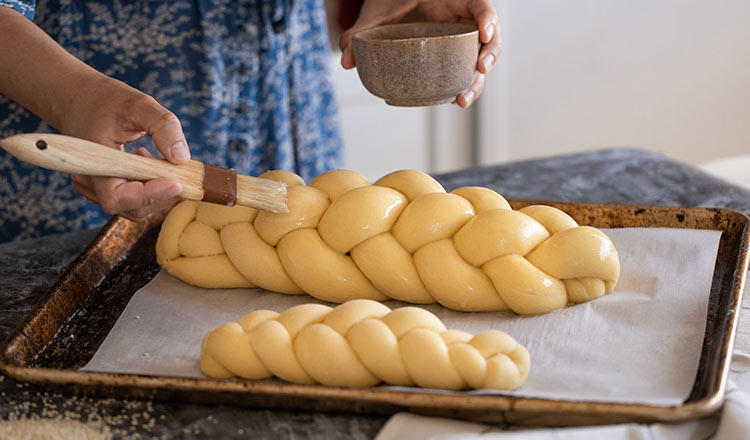Makes 1 large or 2 small loaves
Challah is a special kind of bread, enriched with whole eggs, used for the Jewish Shabbat and holidays. Although challah is generally formed into a braid, other shapes are also traditional, such as a round loaf for Rosh Hashanah.
Ingredients
- 4 1/2 cups bread flour, plus more as needed
- 2 teaspoons active dry yeast
- 1 cup room-temperature water (about 68 to 76°F)
- 3 large eggs (5.3 oz)
- 2 large egg yolks (1 oz)
- 1/4 cup vegetable oil, plus more for greasing
- 1/4 cup sugar
- 2 1/2 teaspoons kosher salt
- Egg wash (1 large egg whisked with 2 tablespoons cold milk or water)
Directions
- Combine the flour and yeast in the bowl of a stand mixer fitted with the dough hook. Add the water, eggs and egg yolks, oil, sugar, and salt and mix on low speed for 4 minutes. Increase the speed to medium, and knead for 4 minutes. The dough should be soft but not sticky.
- Transfer the dough to a lightly oiled bowl, turn to coat, cover with plastic wrap or a damp towel, and let rise in a warm place until nearly doubled in size, about 1 hour.
- Fold the dough gently, cover, and let rest until relaxed, 20 minutes. Divide the dough into 3 equal pieces. Cover and let rest until relaxed, 15 to 20 minutes. Working with 1 piece at a time, place the dough on a lightly floured work surface and press lightly with your fingertips to stretch into a 6- by 10-inch rectangle, using only as much flour as needed to keep the dough from sticking. Fold the long top edge of the dough to the center of the rectangle, pressing lightly with your fingertips to tighten the outer surface of the dough. Fold the dough in half lengthwise so the top edge meets the bottom and use the heel of your palm to seal the edges together; keep the seam straight.
- Roll each piece of dough into a tapered cylinder 12 inches long, increasing the pressure of your hands as you work outward from the center. Lay the 3 ropes of dough parallel to one another.
- Begin braiding in the center of the strands. Place the left strand over the center strand, and then the right strand over the center strand. Continue until you have reached one end, and pinch the ends together tightly. Turn the braid around so that the unbraided strands are facing you. Flip the braid over and repeat the braiding until you have again reached the end of the dough. Pinch the ends together tightly, tuck them under, and place the dough on a parchment paper–lined baking sheet.
- Brush the dough lightly with egg wash and let rise a second time until it springs back slowly to the touch but does not collapse, about 1 hour. Do not cover the dough; the egg wash will make it sticky.
- Preheat the oven to 350°F. Very gently brush the dough with egg wash again before baking. (If the first layer of egg wash is dry before you apply a second coat, the challah will be shinier after it is baked.)
- Bake until the challah is a dark golden brown, shiny, and lightweight, 25 to 30 minutes. Let cool completely on a wire rack before serving.


